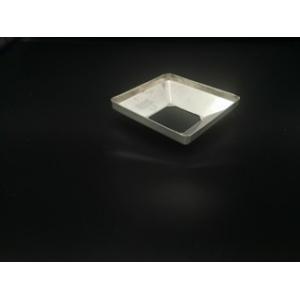

Add to Cart
Deep drawing stainless steel process
The benefits of stainless steel deep drawing
Compared with metal spinning and welding operations, the cycle time
for each piece is shorter.
The integral part can be formed from a single piece of sheet or
plate.
A fairly uniform material thickness can be achieved in the
stainless steel shape.
Deep parts can be produced while avoiding welding.
| Mould material | D2,DC53,YG15,YG20,SKD11/51/61,SKH-9,Cr12mov, Cr12,45#, etc. |
| Product material | copper, brass, metal, stainless steel, BeCu,aluminum |
| Processing methods | Forings,CNC milling and turning,Grinding,Broaching,etc. |
| Processing equipment | CNC machine,Automotic lathe machine,EDM machine,Stamping lathes,Wire-cutting machine,Milling/Grinding machine,Punching/Drilling machine,Ultrasonec cleaning machine,etc. |
| Detection equipment | Projector,Calliper,Height gauge,Screw gauge,Hardness gauge,etc. |
| Application | Electronic:Vehicle parts,CNC machining parts,Wireless receiver metal parts, 3G/4G Modem Wireless Network metal parts,USB housing. Automotive interior parts: connector, navigation frame, car key. All kinds of connectors, digital parts. |
| surface treatment | Plating,Painting,Powder coating,Anodization |
| Vibration grinding,Polishing,Brushing.or according to customer’s requests. | |
| Design software | PROE ,,UG,SOLIDWORK, CAD,etc. |
| Cavity | Single / Multi per request |
| Mould life | 1-30million shots |
| Specification | Many years machining parts processing experience;Precision tolerance less than 0.001mm;Depends on customer’s requirements. |
| Delivery | Normally within 7-45 days (according to customer drawing, quantity and material) special case will be sooner |
| Payment terms | T/T |
| Package | Wooden case or as customer's requirements |
Precautions for the production of stainless steel deep-drawn parts
Due to the fast working hardening speed of stainless steel, more pressure and press energy are required. Generally, compared with ordinary carbon steel of the same thickness, it needs to be increased by 100%.
The mold material must have sufficient hardness and a highly polished surface. D2 is a high chromium alloy tool steel, which is the most commonly used steel in stamping dies. Since stainless steel also contains a high concentration of chromium, it is best to avoid such molding materials in deep drawing and severe forming applications. Whenever sliding occurs between two materials, you must ensure that the materials in contact are different to avoid pain. The best deep drawing performance is usually achieved by using cemented carbide drawing rings or duralumin bronze devices.
Extreme pressure lubricants are essential for deep drawing stainless steel, but soluble oils can be used with aluminum bronze tools. Common practice should include lubricating the sides of the blank to reduce the tendency for timidity.
Polyethylene (PE) or polyvinyl chloride (PVC) plastic film can be applied to the steel surface to help paint and protect the surface surface. These films provide excellent lubrication and have a lower coefficient of friction value than oil. PE is usually sufficient for most purposes, but PVC may be required for serious draws and multiple molding operations. Warning: Both may be difficult to delete and should not be left on the stamped part for a long time. Exposure to the sun may make them impossible to remove.
The pressure of the blank holder is much higher than that of carbon steel. The iron grade (430) requires about 50% of the pressure, while the celestial grade (304, 316) may require up to three times the strength of ordinary carbon steel. This is an important factor that needs to be considered when evaluating news energy and tonnage capacity in the news selection process.
Due to the high pressure and frictional heat, the drawing speed will be much slower than that of ordinary carbon steel. A unique feature of cold-formed stainless steel is that when a slower forming speed is used, more severe deformation may occur. This is very different from ordinary carbon steel. Regardless of the formation speed, the formation form of ordinary carbon steel is almost the same. Generally speaking, when the stainless steel is formed into a difficult shape, the speed is reduced.
Compared with ordinary carbon steel, stainless steel has a larger required gap between the broaching hole and the cavity wall. Generally speaking, celestial grades require alloy thickness plus an additional 35% to 40%: most ferroalloys require material thickness plus 10% to 15% additional clearance.
Cost-saving techniques for stainless steel deep-drawn parts
During cold forming, stainless steel tends to undergo strain hardening, so minimal deformation is ideal.
The design should minimize the ratio of depth to diameter (or
length and width) to avoid the need for a stress relief process.
Normally, before stress relief is needed, the limit is a 2-fold
reduction; in 304 or 316, the ratio of depth to diameter does not
exceed 1:1 in thicker materials.
Starting with approximately 14 gauge (0.074 inches / 1.75 mm) thick
material, stretchability will decrease as the metal thickness
decreases.
